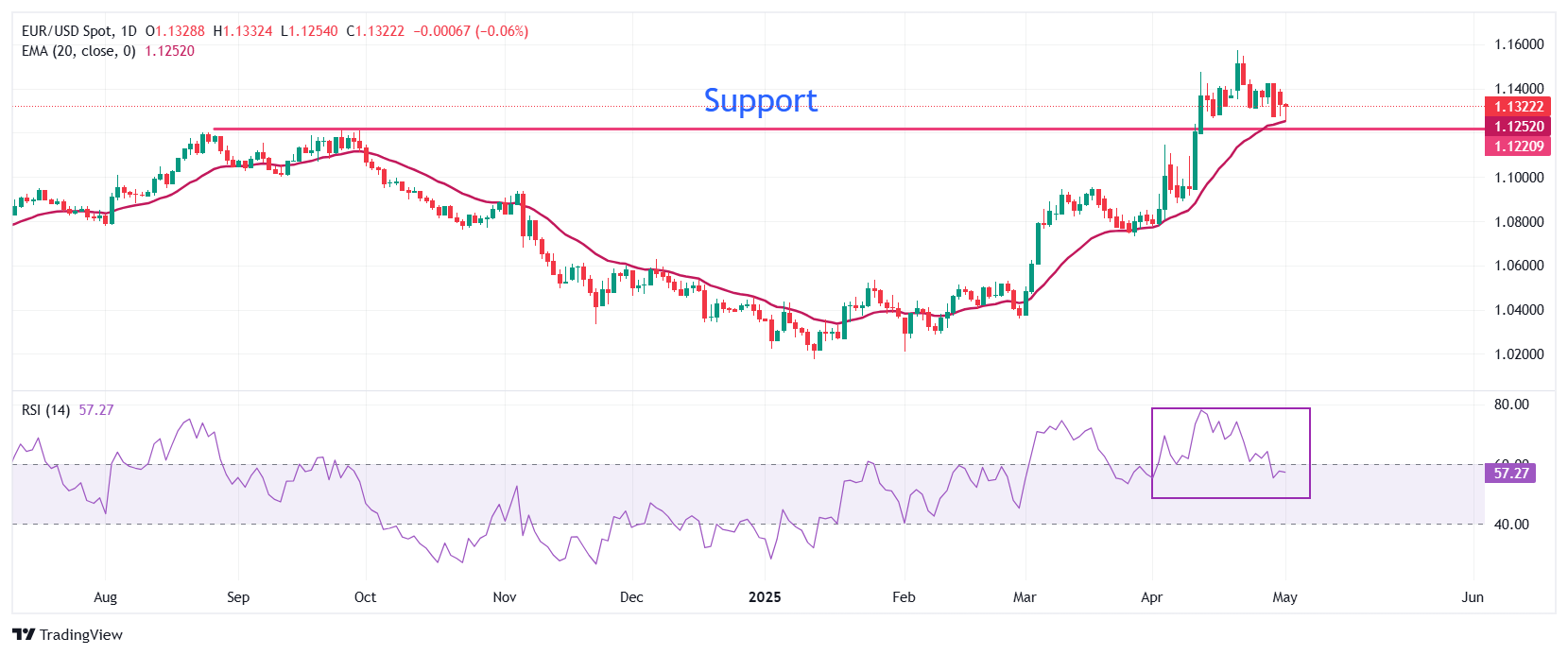EUR/USD bounces back intraday as US Dollar struggles to extend recovery
- EUR/USD rebounds to near 1.1330 as the USD Index struggles to break above the key level of 100.00.
- The US Dollar faces pressure due to a weak US economic outlook in the face of Trump’s tariff policy.
- ECB officials have warned that risks to inflation are skewed to the downside.
EUR/USD recovers its initial losses after sliding to near 1.1285 and flattens around 1.1330 during European trading hours on Thursday. The major currency pair gains ground as the US Dollar Index (DXY), which tracks the Greenback’s value against six major peers, struggles to extend its two-day recovery above the psychological level of 100.00.
The outlook of the US Dollar (USD) looks grim given the unexpected contraction in the United States (US) Q1 Gross Domestic Product (GDP), softer job growth, and US-China trade uncertainty.
Data released Wednesday showed that the US economy declined by 0.3% on an annualized basis as firms frontloaded imports from their foreign suppliers to avoid higher tariffs, which were announced by US President Donald Trump on the so-called “Liberation Day”. This is the first time in three years that the US has faced an economic contraction in a quarter.
Analysts at Morgan Stanley believe that the current GDP data “doesn’t fully reflect the real impact of new economic policies” by US President Trump, and warn of a “slower labor growth, a surge in inflation and a sharp slowdown in retail spending”.
The US ADP reported on Wednesday that the private sector added 62K fresh workers in April, significantly lower than estimates of 108K and the prior release of 147K.
Meanwhile, comments from White House officials have indicated that the US-China trade war will not be resolved in the near term. US Trade Representative Jamieson Greer stated in an interview with Fox News on Wednesday that trade discussions with Beijing have not been initiated yet since the imposition of reciprocal tariffs, the South China Morning Post (SCMP) reported. Greer clarified that no official discussions with Beijing are “underway”.
Daily digest market movers: EUR/USD rebounds as Euro outperforms
- The intraday recovery move in the EUR/USD pair is also driven by the Euro’s outperformance against its peers on Thursday despite firming expectations that the European Central Bank (ECB) will cut interest rates in the June policy meeting. Traders have become increasingly confident that the ECB will reduce its Deposit Facility rate by 25 basis points (bps) to 2% as many officials have warned about downside risks to Eurozone inflation.
- ECB officials have expressed concerns that Eurozone inflation could undershoot the central bank’s target of 2%. ECB policymakers believe that growth will be hit badly by the fallout of tariffs by US President Trump and that its impact will be “net disinflationary” for the continent.
- For fresh cues on inflation, investors await the preliminary Eurozone Harmonized Index of Consumer Prices (HICP) data for April, which will be released on Friday. According to the estimates, the headline HICP rose at a moderate pace of 2.1% on year, slightly lower than the 2.2% increase seen in March. In the same period, the core HICP, which excludes volatile components like food, energy, alcohol, and tobacco, is expected to have grown at a faster pace of 2.5% compared to the prior reading of 2.4%..
- Ahead of the Eurozone HICP, the inflation data from its major member states have indicated that price pressures cooled down in Germany and France but remained stable in Spain and Italy.
- Meanwhile, flash Eurozone Q1 GDP came in stronger-than-expected on both a quarterly and annual basis. Eurostat reported that the economy grew by 0.4% quarter-on-quarter, higher than what economists had expected and the previous reading of 0.2%. However, the Q1 GDP data doesn’t yet reflect the impact of tariffs by US President Trump on automobiles.
Technical Analysis: EUR/USD aims to hold 1.1300

EUR/USD strives to hold the key level of 1.1300 in Thursday’s European session. The pair bounces back after a mean-reversion to near the 20-day Exponential Moving Average (EMA), which trades around 1.1250.
The 14-day Relative Strength Index (RSI) falls inside the 40.00-60.00 range, indicating that the bullish momentum is concluded for now. However, the upside bias still prevails.
Looking up, the psychological level of 1.1500 will be the major resistance for the pair. Conversely, the 25 September high of 1.1214 will be a key support for the Euro bulls.
Euro FAQs
The Euro is the currency for the 19 European Union countries that belong to the Eurozone. It is the second most heavily traded currency in the world behind the US Dollar. In 2022, it accounted for 31% of all foreign exchange transactions, with an average daily turnover of over $2.2 trillion a day. EUR/USD is the most heavily traded currency pair in the world, accounting for an estimated 30% off all transactions, followed by EUR/JPY (4%), EUR/GBP (3%) and EUR/AUD (2%).
The European Central Bank (ECB) in Frankfurt, Germany, is the reserve bank for the Eurozone. The ECB sets interest rates and manages monetary policy. The ECB’s primary mandate is to maintain price stability, which means either controlling inflation or stimulating growth. Its primary tool is the raising or lowering of interest rates. Relatively high interest rates – or the expectation of higher rates – will usually benefit the Euro and vice versa. The ECB Governing Council makes monetary policy decisions at meetings held eight times a year. Decisions are made by heads of the Eurozone national banks and six permanent members, including the President of the ECB, Christine Lagarde.
Eurozone inflation data, measured by the Harmonized Index of Consumer Prices (HICP), is an important econometric for the Euro. If inflation rises more than expected, especially if above the ECB’s 2% target, it obliges the ECB to raise interest rates to bring it back under control. Relatively high interest rates compared to its counterparts will usually benefit the Euro, as it makes the region more attractive as a place for global investors to park their money.
Data releases gauge the health of the economy and can impact on the Euro. Indicators such as GDP, Manufacturing and Services PMIs, employment, and consumer sentiment surveys can all influence the direction of the single currency. A strong economy is good for the Euro. Not only does it attract more foreign investment but it may encourage the ECB to put up interest rates, which will directly strengthen the Euro. Otherwise, if economic data is weak, the Euro is likely to fall. Economic data for the four largest economies in the euro area (Germany, France, Italy and Spain) are especially significant, as they account for 75% of the Eurozone’s economy.
Another significant data release for the Euro is the Trade Balance. This indicator measures the difference between what a country earns from its exports and what it spends on imports over a given period. If a country produces highly sought after exports then its currency will gain in value purely from the extra demand created from foreign buyers seeking to purchase these goods. Therefore, a positive net Trade Balance strengthens a currency and vice versa for a negative balance.

